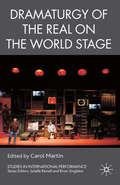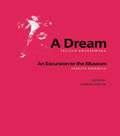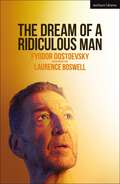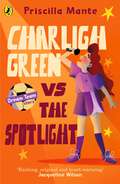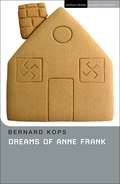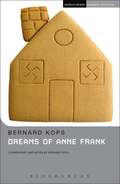- Table View
- List View
The Dramaturgy of Space (Theatre Makers)
by Ramón GrifferoIn Ramón Griffero's seminal work, The Dramaturgy of Space, the playwright and director describes his aesthetic philosophy and theoretical approach to theatrical creation, illustrating his theory through practical application in a series of exercises.As well as touching upon some of Griffero's own work, like Cinema utopia (1985), Tus deseos en fragmentos (2003), Fin del eclipse (2007) and El azar de la fiesta (1992), this book also reinforces the practicality of Griffero's concepts through a series of online videos, breaking down each exercise and allowing readers to engage with the effects of his celebrated approach.Published here in English for the first time, in a translation by the leading expert on Griffero, The Dramaturgy of Space reveals the internationally renowned Chilean artist's thought process, and how his practice has influenced the theatrical, political, and social context, from the Pinochet dictatorship to the present day.
The Dramaturgy of the Door
by Stuart Andrews Matthew WagnerThe Dramaturgy of the Door examines the door as a critical but under-explored feature of theatre and performance, asking how doors function on stage, in site-specific practice and in performances of place. This first book-length study on the topic argues that doors engage in and help to shape broad phenomena of performance across key areas of critical enquiry in the field. Doors open up questions of theatrical space(s) and artistic encounters with place(s), design and architecture, bodies and movement, interior versus exterior, im/materiality, the relationship between the real and the imaginary, and processes of transformation. As doors separate places and practices, they also invite us to see connections and contradictions between each one and to consider the ways in which doors frame the world beyond the stage and between places of performance. With a wide-ranging set of examples – from Shakespeare’s Macbeth to performance installations in the Mojave Desert – The Dramaturgy of the Door is aimed at performance makers and artists as well as advanced students and scholars in the fields of performance studies, cultural theory, and visual arts.
The Dramaturgy of the Door
by Stuart Andrews Matthew WagnerThe Dramaturgy of the Door examines the door as a critical but under-explored feature of theatre and performance, asking how doors function on stage, in site-specific practice and in performances of place. This first book-length study on the topic argues that doors engage in and help to shape broad phenomena of performance across key areas of critical enquiry in the field. Doors open up questions of theatrical space(s) and artistic encounters with place(s), design and architecture, bodies and movement, interior versus exterior, im/materiality, the relationship between the real and the imaginary, and processes of transformation. As doors separate places and practices, they also invite us to see connections and contradictions between each one and to consider the ways in which doors frame the world beyond the stage and between places of performance. With a wide-ranging set of examples – from Shakespeare’s Macbeth to performance installations in the Mojave Desert – The Dramaturgy of the Door is aimed at performance makers and artists as well as advanced students and scholars in the fields of performance studies, cultural theory, and visual arts.
Dramaturgy of the Real on the World Stage (Studies in International Performance)
by C. MartinThe Dramaturgy of the Real brings together an incredible range of international theatre thinking, plays and performance texts, many published here for the first time, that ask questions about how we have come to understand reality and truth in the twenty-first century and analyze the presentation of non-fiction on the international stage.
Dramaturgy to Make Visible: The Legacies of New Dramaturgy for Politics and Performance in Our Times (ISSN)
by Peter EckersallThis book argues that dramaturgy makes things visible and does so in two distinct and interrelating ways: creative processes and formal elements of performance are rendered visible and readable; and performance dramaturgy becomes an expanded practice in which performance is a locus for creating wide-ranging events and activities.This exploration defines dramaturgy as a perceptibly transforming agency in the construction, presentation and reception of contemporary performance; and it shows how contemporary performance has an intrinsic dramaturgical aspect whose proliferation of dramaturgical practices has led to a far-reaching reinvention of what contemporary theatre is. In doing so, this book deals with a careful selection of performance practices, including theatrical adaptations, new media dramaturgy, contemporary dance, installation-performance, postdramatic theatre, visionary works by auteurs, and revivals of well-known stage shows.This study will be of great interest to students and scholars in theater studies, performance studies, cultural studies, curating, and dance scholarship.
Dramaturgy to Make Visible: The Legacies of New Dramaturgy for Politics and Performance in Our Times (ISSN)
by Peter EckersallThis book argues that dramaturgy makes things visible and does so in two distinct and interrelating ways: creative processes and formal elements of performance are rendered visible and readable; and performance dramaturgy becomes an expanded practice in which performance is a locus for creating wide-ranging events and activities.This exploration defines dramaturgy as a perceptibly transforming agency in the construction, presentation and reception of contemporary performance; and it shows how contemporary performance has an intrinsic dramaturgical aspect whose proliferation of dramaturgical practices has led to a far-reaching reinvention of what contemporary theatre is. In doing so, this book deals with a careful selection of performance practices, including theatrical adaptations, new media dramaturgy, contemporary dance, installation-performance, postdramatic theatre, visionary works by auteurs, and revivals of well-known stage shows.This study will be of great interest to students and scholars in theater studies, performance studies, cultural studies, curating, and dance scholarship.
Draping Period Costumes: (The Focal Press Costume Topics Series) (The Focal Press Costume Topics Series)
by Sharon SobelOne way of creating a theatrical costume is called flat patterning. This is when a costume designer uses a pattern made to the wearer's measurements to cut out and sew together a costume. In many cases flat patterning is the more appropriate method for creating a period costume - skirts, pants, and sleeves, for example. However, working in two-dimensions often does not translate correctly onto a three-dimensional dress form or person. Often a designer will need to tweak style lines on a garment once they see it worn, or a costume will need a quick adjustment right before going on stage. In those cases, designers need to know how to correctly drape a costume. Draping is also the best way to construct a period costume right from the start. The construction of garments in earlier centuries often constricted movement, especially in the area of the armhole. The very different size and proportions of contemporary people compared to those in previous centuries makes the use of period patterns difficult. A well-draped garment can give the impression of period accuracy while permitting the wearer greater freedom of movement. Having a mock-up pinned to the form in its early stages is quicker and easier to adapt than drafting a flat pattern, cutting it out of muslin and sewing it. It also provides the opportunity for greater creativity and adaptation as well as a better understanding of what fabric will and won't do. In Draping Period Costumes, Sharon Sobel explains in step-by-step detail the basics of draping and demonstrates the use of those basic skills in the creation of a representative selection of period costumes from a variety of time periods. Chapters are broken into time periods and have two parts: an analysis of how clothing was made and worn during that specific time period, and detailed instruction on draping techniques to construct the costume. Copiously illustrated, images allow this visual audience to easily follow along with detailed instructions. A part of the Costume Topics series, this book will be 256 pages, a snazzy 8.25 x 7.5 trim size, and spiral bound-a format consistently requested by our audience so that they can lay the book flat while working from it.
Draping Period Costumes: (The Focal Press Costume Topics Series) (The Focal Press Costume Topics Series)
by Sharon SobelOne way of creating a theatrical costume is called flat patterning. This is when a costume designer uses a pattern made to the wearer's measurements to cut out and sew together a costume. In many cases flat patterning is the more appropriate method for creating a period costume - skirts, pants, and sleeves, for example. However, working in two-dimensions often does not translate correctly onto a three-dimensional dress form or person. Often a designer will need to tweak style lines on a garment once they see it worn, or a costume will need a quick adjustment right before going on stage. In those cases, designers need to know how to correctly drape a costume. Draping is also the best way to construct a period costume right from the start. The construction of garments in earlier centuries often constricted movement, especially in the area of the armhole. The very different size and proportions of contemporary people compared to those in previous centuries makes the use of period patterns difficult. A well-draped garment can give the impression of period accuracy while permitting the wearer greater freedom of movement. Having a mock-up pinned to the form in its early stages is quicker and easier to adapt than drafting a flat pattern, cutting it out of muslin and sewing it. It also provides the opportunity for greater creativity and adaptation as well as a better understanding of what fabric will and won't do. In Draping Period Costumes, Sharon Sobel explains in step-by-step detail the basics of draping and demonstrates the use of those basic skills in the creation of a representative selection of period costumes from a variety of time periods. Chapters are broken into time periods and have two parts: an analysis of how clothing was made and worn during that specific time period, and detailed instruction on draping techniques to construct the costume. Copiously illustrated, images allow this visual audience to easily follow along with detailed instructions. A part of the Costume Topics series, this book will be 256 pages, a snazzy 8.25 x 7.5 trim size, and spiral bound-a format consistently requested by our audience so that they can lay the book flat while working from it.
Drawing and Rendering for Theatre: A Practical Course for Scenic, Costume, and Lighting Designers
by Clare P. RoweDrawing and Rendering for Theatre, A Practical Course for Scenic, Costume, and Lighting Designers is designed for those of you who are theatrical designers and want to improve your drawing and rendering skills.This gorgeous full-color book includes many examples of student drawings, analyzed and critiqued for areas that need improvement. It also includes numerous examples of design renderings by professional theatrical designers. In addition to the general sections on drawing and painting, it includes separate chapters on costume, scenic, and lighting rendering that include information specific to these design areas.
Drawing and Rendering for Theatre: A Practical Course for Scenic, Costume, and Lighting Designers
by Clare P. RoweDrawing and Rendering for Theatre, A Practical Course for Scenic, Costume, and Lighting Designers is designed for those of you who are theatrical designers and want to improve your drawing and rendering skills.This gorgeous full-color book includes many examples of student drawings, analyzed and critiqued for areas that need improvement. It also includes numerous examples of design renderings by professional theatrical designers. In addition to the general sections on drawing and painting, it includes separate chapters on costume, scenic, and lighting rendering that include information specific to these design areas.
Drawing the Line: Technical Hand Drafting for Film and Television
by David McHenryThis is the definitive guide for all aspects of scenic hand drafting for film and television, now comprehensively updated and revised for its second edition. Author, David McHenry, utilizes 45 years of experience as a Designer, Art Director, Storyboard Artist, and Draftsman to provide readers with an accessible step-by-step guide of professional techniques, tools, and workflows. Readers will discover how to draw the iconic scroll of a classical column or learn the difference between Flemish and English bond brickwork, as well as all four types of drafting projection in detail: isometric, oblique, orthographic, and axonometric. Also included is hard-to-find information on lens angles and their calculation for different screen aspect ratios, how to create a lens projection image of a set with a given lens, height, and aspect ratio, and how to create forced perspective. Beautifully illustrated with carefully crafted hand-drawn illustrations on every page, this thoroughly revised text has been updated to include new examples and exercises and a revised glossary, making it the ideal step-by-step guide to hand drafting for film and television. This is an essential resource for students of drafting for film and television, scenic design, and art direction courses. It will also hugely benefit professionals studying or working in film and television design.
Drawing the Line: Technical Hand Drafting for Film and Television
by David McHenryDrawing the Line: Technical Hand Drafting for Film and Television is the essential resource for students and aspiring professionals studying and working in film and television design. The book covers all aspects of scenic drafting by hand – a technique still used in film and television because of its unparalleled emotive and aesthetic qualities. Discover how to draw the iconic scroll of a classical column or learn the difference between Flemish bond and English bond brickwork – it is all here! Other key features include the following: Beautifully illustrated, approachable, step-by-step instructions for every aspect of scenic drafting – specific to film and television; Illustrated explanations of camera lenses, including calculating aspect ratios and projections; Coverage of the four types of drafting projection: isometric, oblique, orthographic and axonometric; A comprehensive glossary of terms, including an illustration of each entry. This beautiful book is clear, accessible, and a must-have for any student aspiring to work in film and television design.
A Dream
by Felicja KruszewskaThe translation of Felicja Kruszewska's A Dream introduces a major play by a twentieth-century female playwright to the English-speaking world. On March 7, 1927 A Dream - a large-scale expressionistic drama by an unknown poet - burst on the Polish theatrical scene in a dazzling debut production by the young actor Edmund Wiercinski, who would become one of the outstanding directors of his time. The play's hallucinatory visions of the rise of fascism and the heroine's longing for a providential savior on a white horse spoke directly to Polish audiences about their deepest anxieties. During the next two years A Dream received three additional stagings and became the subject of lively debate and controversy. The play, which has been successfully revived in 1974, is an outstanding example of European expressionism. The volume also contains An Excursion to the Museum, by the contemporary Polish poet, playwright, and short-story writer Tadeusz Rozewicz. A disturbing account of an utterly mundane visit to Auschwitz, the tale is a brilliant example of the playwright's technique of poetic collage.
A Dream
by Felicja KruszewskaThe translation of Felicja Kruszewska's A Dream introduces a major play by a twentieth-century female playwright to the English-speaking world. On March 7, 1927 A Dream - a large-scale expressionistic drama by an unknown poet - burst on the Polish theatrical scene in a dazzling debut production by the young actor Edmund Wiercinski, who would become one of the outstanding directors of his time. The play's hallucinatory visions of the rise of fascism and the heroine's longing for a providential savior on a white horse spoke directly to Polish audiences about their deepest anxieties. During the next two years A Dream received three additional stagings and became the subject of lively debate and controversy. The play, which has been successfully revived in 1974, is an outstanding example of European expressionism. The volume also contains An Excursion to the Museum, by the contemporary Polish poet, playwright, and short-story writer Tadeusz Rozewicz. A disturbing account of an utterly mundane visit to Auschwitz, the tale is a brilliant example of the playwright's technique of poetic collage.
The Dream of a Ridiculous Man (Modern Plays)
by Fyodor DostoevskyMad – Foolish – Ridiculous – I've been called many things.On an uneventful Wednesday in a drab Borough of East London, an ordinary man has a startling revelation: life is an unhappy accident in a meaningless universe.He gets himself a gun.But before he can use it, he dreams of an innocent, alternative earth, where people live in harmony with nature and each other. Elated, he sets out to tell the world about his dream and share his new vision of a happy planet.Dostoevsky's tragic-comic adventure The Dream of a Ridiculous Man is transported to 21st-century London in a one-person tale of wonder with an urgent warning for our world, adapted by Laurence Boswell. A funny and serious story of hope, that with love and trust we can build a better world. Maybe.This edition was published to coincide with the world premiere at London's Marylebone Theatre in March 2024.
The Dream of a Ridiculous Man (Modern Plays)
by Fyodor DostoevskyMad – Foolish – Ridiculous – I've been called many things.On an uneventful Wednesday in a drab Borough of East London, an ordinary man has a startling revelation: life is an unhappy accident in a meaningless universe.He gets himself a gun.But before he can use it, he dreams of an innocent, alternative earth, where people live in harmony with nature and each other. Elated, he sets out to tell the world about his dream and share his new vision of a happy planet.Dostoevsky's tragic-comic adventure The Dream of a Ridiculous Man is transported to 21st-century London in a one-person tale of wonder with an urgent warning for our world, adapted by Laurence Boswell. A funny and serious story of hope, that with love and trust we can build a better world. Maybe.This edition was published to coincide with the world premiere at London's Marylebone Theatre in March 2024.
Dream of Perfect Sleep (Oberon Modern Plays Ser.)
by Kevin KautzmanDream of Perfect Sleep is the story of an aging couple, Mary and Gene, and their adult children – recovering-addict Robert and new-ager Melissa. Mary suffers from severe vertigo and just wants to watch her TV show. Gene’s busy organizing a very special holiday dinner, but party planning isn’t exactly his strong suit. When the estranged kids come home for the holidays, Gene reveals some unexpected news that threatens to destroy the family’s already strained bonds… A funny, heartwarming and powerful story of hope and loss in the face of dementia and terminal illness as an elderly couple plan their last days on Earth. Winner of both the Kernodle New Play and Southwestern Playwriting Awards, Dream of Perfect Sleep receives its world premiere at the Finborough Theatre. It was originally conceived at the University of Texas at Austin with the support of a fellowship from the Michener Center for Writers. It has received developmental workshops and readings around the United States including a workshop with Page 73 in New York City and with American Actors UK at the Tristan bates Theatre, London.
Dream of the Dog (Oberon Modern Plays)
by Craig HigginsonKwaZulu-Natal, South Africa, shortly after the millennium. Patricia and Richard Wiley, an elderly white couple, are packing up to leave the farm they’ve sold to developers. Their preparations are interrupted by the arrival of a young man – ‘Look Smart’ – who used to be one of the black workers on their estate until he disappeared fifteen years ago. The day before Look Smart left, something terrible happened on the Wileys’ farm. But everyone has a different memory of the dreadful event and their own role in it. As the different accounts of their shared past are unravelled, they are all forced to confront their own versions of the truth – with shocking ramifications for their lives today. Dream of the Dog is a richly textured and complex story of South Africa’s emerging democracy, and its continued negotiation with its past in order to find a workable identity for its future. Critically acclaimed in South Africa, this new play takes an unflinching look at the twin mantras of the post-Mandela age – reconciliation and forgiveness – as it asks whether black and white can ever live together peacefully.
Dream Sequences in Shakespeare: A Psychoanalytic Perspective
by Meg Harris WilliamsThis book takes a new approach to Shakespeare’s plays, exploring them as dream-thought in the modern psychoanalytic sense of unconscious thinking. Through his commitment to poetic language, Shakespeare offers images and dramatic sequences that illustrate fundamental developmental conflicts, the solutions for which are not preconceived but evolve through the process of dramatisation. In this volume, Meg Harris Williams explores the fundamental distinction between the surface meanings of plot or argument and the deep grammar of dreamlife, applied not only to those plays known as ‘dream-plays’ but also to critical sequences throughout Shakespeare’s oeuvre. Through a post-Kleinian model based on the thinking of Bion, Meltzer, and Money-Kyrle, this book sheds new light on both Shakespeare’s own relation to the play and on the identificatory processes of the playwright, reader, or audience. Dream Sequences in Shakespeare is important reading for psychoanalysts, playwrights, and students.
Dream Sequences in Shakespeare: A Psychoanalytic Perspective
by Meg Harris WilliamsThis book takes a new approach to Shakespeare’s plays, exploring them as dream-thought in the modern psychoanalytic sense of unconscious thinking. Through his commitment to poetic language, Shakespeare offers images and dramatic sequences that illustrate fundamental developmental conflicts, the solutions for which are not preconceived but evolve through the process of dramatisation. In this volume, Meg Harris Williams explores the fundamental distinction between the surface meanings of plot or argument and the deep grammar of dreamlife, applied not only to those plays known as ‘dream-plays’ but also to critical sequences throughout Shakespeare’s oeuvre. Through a post-Kleinian model based on the thinking of Bion, Meltzer, and Money-Kyrle, this book sheds new light on both Shakespeare’s own relation to the play and on the identificatory processes of the playwright, reader, or audience. Dream Sequences in Shakespeare is important reading for psychoanalysts, playwrights, and students.
The Dream Team: Charligh Green vs. The Spotlight (The Dream Team)
by Priscilla ManteThe next amazing book in THE DREAM TEAM series!Praise for Jaz Santos vs. The World:'Exciting, original and heart-warming' - Jacqueline Wilson'Priscilla Mante is an author to watch' - Aisha Bushby---A heart-warming, inclusive and funny new story about three big F's: friends, following your dreams and football!Hi! I'm Charligh, and one day I'm going to be a big star. I'm full of PIZZAZZ after all, and everyone I've ever met tells me I'm unforgettable. In a good way, I think . . . I've always loved attention, but at the moment, there's a teeny tiny chance I'm getting it for all the wrong reasons. For starters, me and my very-nearly-world-famous team, the Bramrock Stars, are trying to win big against our rivals in the new league. But I can't stop tripping over the ball! And although I've got my dream part in the school play, the words just won't stick in my head. What's going to happen if I can't learn my lines? Luckily for me, my best friends really are the bestest, and I know they'll help me whatever it takes. It's time for me to step into the spotlight, and prove girls really can do anything!
Dreaming (Modern Plays)
by Peter BarnesA haunting and brutally funny story of heroism and human valuesIn the bloody aftermath of the Wars of the Roses, Captain John Mallory leads a band of renegades across a war-torn landscape on a breathtaking quest in search of a dream - a dream of home. Dreaming premiered at the Royal Exchange Theatre in March 1999 before moving to the West End."Peter Barnes is one of the unrecognised geniuses of the English theatre" (Plays and Players)
Dreaming: Dreaming For A Better World (Modern Plays)
by Peter BarnesA haunting and brutally funny story of heroism and human valuesIn the bloody aftermath of the Wars of the Roses, Captain John Mallory leads a band of renegades across a war-torn landscape on a breathtaking quest in search of a dream - a dream of home. Dreaming premiered at the Royal Exchange Theatre in March 1999 before moving to the West End."Peter Barnes is one of the unrecognised geniuses of the English theatre" (Plays and Players)
Dreams Of Anne Frank
by Bernard Kops"In celebrating the spirit of optimism that shines through the thoughts and dreams of one extraordinary thirteen-year-old during the darkest of times, Bernard Kops has created a dramatic masterpiece" (Time Out)"This play has been a catalyst in stimulating young people not only to question the past but also to confront the very real issues of racism today." (Jenny Culank, Artistic Director of Classworks Theatre, Cambridge)In 1942 Anne Frank, a young Jewish girl, was forced into hiding with seven others in a secret annexe in Amsterdam. Dreams of Anne Frank vividly brings her story to life in a poignant and highly charged drama. Using actors, movement and song Bernard Kops re-imagines and explores Anne Frank's hidden world, a world in which she lived, fell in love and dreamed of freedom.Dreams of Anne Frank won the 1993 Time Out award for best children's production and has been performed around the world.Commentary and notes by Bernard Kops
Dreams Of Anne Frank: Dreams Of Anne Frank, On Margate Sands, Call In The Night (Student Editions)
by Bernard Kops"In celebrating the spirit of optimism that shines through the thoughts and dreams of one extraordinary thirteen-year-old during the darkest of times, Bernard Kops has created a dramatic masterpiece" (Time Out)"This play has been a catalyst in stimulating young people not only to question the past but also to confront the very real issues of racism today." (Jenny Culank, Artistic Director of Classworks Theatre, Cambridge)In 1942 Anne Frank, a young Jewish girl, was forced into hiding with seven others in a secret annexe in Amsterdam. Dreams of Anne Frank vividly brings her story to life in a poignant and highly charged drama. Using actors, movement and song Bernard Kops re-imagines and explores Anne Frank's hidden world, a world in which she lived, fell in love and dreamed of freedom.Dreams of Anne Frank won the 1993 Time Out award for best children's production and has been performed around the world.Commentary and notes by Bernard Kops


